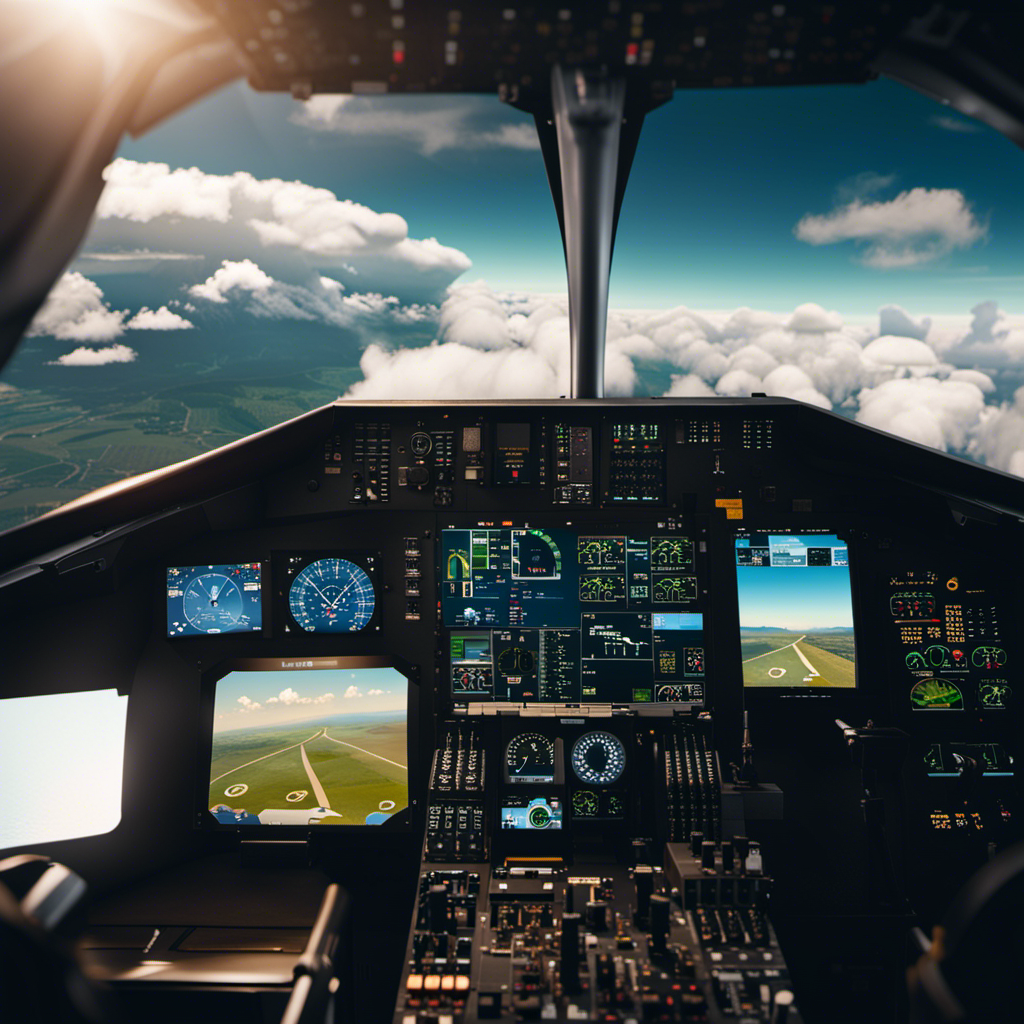Are you prepared to soar and explore the skies? If so, you’re in luck because you’ve found the perfect spot. Within this article, I will serve as your navigator, directing you to the finest flight schools in your vicinity.
We’ll dive into the world of flight schools and training centers, exploring everything from budget considerations to safety measures. With my expert advice, you’ll be soaring through the clouds in no time.
Let’s get started on this thrilling journey together.
Key Takeaways
- Flexible scheduling options are available, allowing for part-time or full-time training programs, evening or weekend classes, and customizable training schedules.
- Taking a discovery flight offers the opportunity to experience the thrill of flying firsthand, determine if flying is enjoyable, meet instructors and staff, ask questions, and get a sense of teaching style while seeing the training facilities and aircraft.
- Comparing costs and financing options is important as flight training is a significant investment. It allows for the evaluation of different schools and financial options to find the best fit for your budget.
- When selecting a flight school, factors to consider include the location and facilities offered, the assessment of curriculum and training methods, the evaluation of experience and qualifications of instructors, and ensuring alignment with learning style and objectives for a successful flying journey.
Research Flight Schools and Training Centers in Your Area
If you’re looking to become a pilot, start by researching flight schools and training centers in your area. Learning to fly at a local flight school offers several benefits.
First, it allows you to become familiarized with the airspace and weather conditions specific to your region, which is crucial for safe flying. Additionally, local flight schools often have strong connections with local aviation communities, providing you with networking opportunities and potential career prospects.
When choosing the right flight school for your goals, consider factors such as the school’s reputation, instructor qualifications, and available training aircraft. Look for schools that offer a variety of training programs tailored to different pilot certifications. It’s also important to visit the school, meet the instructors, and observe their teaching methods to ensure it aligns with your learning style.
By thoroughly researching and selecting the right local flight school, you’re setting yourself up for a successful aviation journey.
Now, let’s move on to considering your budget and time commitment.
Consider Your Budget and Time Commitment
When considering learning to fly, it’s important to think about your budget and the amount of time you can commit. Flying lessons can be expensive, so it’s crucial to have a clear understanding of your financial limitations. Additionally, flying requires a significant time commitment, as regular practice is necessary to build and maintain skills. To help you gauge the potential costs and time requirements, I have prepared a table outlining some common budget considerations and time commitments associated with learning to fly:
| Budget Considerations | Time Commitment |
|---|---|
| Aircraft Rental | Ground School |
| Instructor Fees | Flight Training |
| Study Materials | Practice Time |
| Insurance | Exams |
| License Fees | Flight Hours |
Read Reviews and Ask for Recommendations
To gather information about flight schools or training centers, it’s helpful to read reviews and ask for recommendations from experienced pilots or aviation enthusiasts. Reading online forums and visiting local aviation events are also great ways to gather valuable insights.
Online forums provide a platform for pilots and enthusiasts to share their experiences and offer recommendations based on their personal experiences. Attending local aviation events allows you to interact directly with experienced pilots and trainers who can provide first-hand recommendations.
These sources of information can help you identify reputable flight schools or training centers that have a good track record and positive reviews. By taking the time to gather this information, you can make a more informed decision about which schools or centers to consider.
Now, let’s move on to the next important aspect: checking for accreditation and safety measures.
Check for Accreditation and Safety Measures
Checking for accreditation and safety measures is essential when selecting a flight school or training center. Ensuring that the school or center is accredited means that it has met certain standards and is recognized by industry professionals. This gives me confidence that I am receiving quality training and that my investment in time and money is well-placed.
Safety measures are equally important because I want to learn in an environment that prioritizes my well-being. Additionally, when considering the importance of location and my personal goals, I want to find a school or center that is conveniently located and offers the type of training that aligns with my aspirations.
By prioritizing accreditation and safety measures, I can be confident that I am taking the necessary steps towards becoming a skilled pilot.
Speaking of steps, another vital aspect to consider is finding experienced and qualified instructors.
Look for Experienced and Qualified Instructors
Experienced and qualified instructors are crucial when selecting a flight school or training center. As someone who has been through the process of finding the right flight school, I understand the importance of instructor qualifications. Here are four key reasons why instructor qualifications should be a top priority:
-
Safety: Skilled instructors with extensive flight experience can ensure a safe and secure learning environment.
-
Knowledge transfer: Qualified instructors possess the expertise to effectively teach complex aviation concepts, helping students understand and apply them.
-
Confidence building: Instructors who have a solid track record can instill confidence in students, boosting their motivation and overall progress.
-
Networking opportunities: Experienced instructors often have connections within the aviation industry, providing valuable networking opportunities for aspiring pilots.
With the right instructors guiding your training, you’ll be better prepared to evaluate the training aircraft and facilities without compromising your progress.
Evaluate the Training Aircraft and Facilities
After considering the experience and qualifications of the instructors, it’s crucial to evaluate the training aircraft and facilities offered by the flight schools.
When comparing training aircraft, it’s essential to look for aircraft that are suitable for student pilots, such as those equipped with dual controls and modern avionics systems. Additionally, factors such as the aircraft’s maintenance history and availability should be taken into account.
As for the facilities, they should provide a conducive learning environment, including well-maintained classrooms, briefing rooms, and simulators. The quality and condition of the training facilities can significantly impact the learning experience.
By thoroughly assessing the training aircraft and facilities, prospective pilots can ensure they receive the best possible training.
Now, let’s consider the availability of training programs and scheduling options.
Consider the Availability of Training Programs and Scheduling Options
When considering flight training, it’s important to evaluate the availability of training programs and scheduling options. Finding the right flight school is crucial for aspiring pilots, as it can greatly impact the quality of their training and their overall experience.
When looking for a training program, it’s essential to consider factors such as the curriculum, instructor qualifications, and the types of aircraft available for training. Additionally, finding the best time to train is crucial. Many flight schools offer flexible scheduling options to accommodate the needs of aspiring pilots, such as part-time or full-time training programs, evening or weekend classes, and customizable training schedules.
Take a Discovery Flight to Get a Feel for the School
Taking a discovery flight is a great way to get a feel for the flight school and see if it’s the right fit for you. There are several benefits of taking a discovery flight before committing to flight school.
Firstly, it allows you to experience the thrill of flying firsthand and determine if it’s something you truly enjoy. Additionally, it gives you the opportunity to meet the instructors and staff, ask questions, and get a sense of their teaching style and expertise.
To make the most out of your discovery flight experience, it’s important to come prepared with a list of questions and objectives. Discuss your goals and expectations with the instructor, and ask to see the training facilities and aircraft.
Compare Costs and Financing Options
It’s important to compare costs and financing options when considering flight school. Flight training can be a significant investment, so it’s crucial to evaluate different schools and their financial options to find the best fit for your budget. To help you make an informed decision, I have prepared a cost comparison table of three flight schools in your area:
| Flight School | Tuition Cost (per hour) | Financing Options |
|---|---|---|
| Sky High Aviation | $150 | Scholarships, Loans, Payment plans |
| Wings of Freedom | $175 | Grants, Loans, In-house financing |
| Airborne Academy | $130 | Payment plans, Loans, Scholarships |
Make an Informed Decision and Start Your Flying Journey
To make an informed decision and start your flying journey, be sure to thoroughly evaluate the costs and financing options of different flight schools. Making the right choice is crucial when it comes to learning how to fly.
Consider your goals and expectations before selecting a flight school. Determine whether you want to pursue a private pilot license or aim for a commercial pilot career. Research the curriculum and training methods of each school to ensure they align with your learning style and objectives. Evaluate the experience and qualifications of the instructors to ensure they can provide the necessary guidance and mentorship.
Additionally, consider the location and facilities offered by the flight school. By carefully assessing these factors, you can make an informed decision and embark on a successful flying journey.
Frequently Asked Questions
What are the specific safety measures and accreditation to look for in a flight school?
When considering flight schools, it’s important to prioritize safety measures and accreditation. Look for schools that have a comprehensive safety program, experienced instructors, and accreditation from recognized aviation organizations like the FAA or EASA.
How can I evaluate the training aircraft and facilities of a flight school?
When evaluating flight schools, I assess the training aircraft for safety, maintenance records, and suitability for my goals. I compare flight instructors based on their experience, qualifications, and teaching methods. Additionally, I carefully compare the fees of different flight schools to ensure I am getting the best value for my training.
What are the different training programs and scheduling options available at flight schools?
Flight schools offer a variety of training programs and scheduling options. From private pilot to commercial pilot, you can choose based on your goals and budget. Flight school pricing varies, as does the qualifications of flight instructors.
What is a discovery flight and how can it help me in choosing a flight school?
A discovery flight is a valuable tool for selecting a flight school. It allows you to experience the thrill of flying firsthand and assess the school’s instructors, facilities, and teaching methods.
What are the different financing options available for flight training?
There are various financing options available for flight training, such as loans, installment plans, and private funding. Additionally, scholarship opportunities can help offset the costs of training for aspiring pilots.
Conclusion
In conclusion, finding the best place to learn to fly near you requires careful research and consideration.
By evaluating flight schools and training centers in your area, considering your budget and time commitment, and checking for accreditation and safety measures, you can make an informed decision.
Don’t forget to read reviews and ask for recommendations, ensuring you choose experienced instructors and a program that fits your schedule.
So, are you ready to take to the skies and begin your flying journey?
With a heart that soars as high as the skies, Aria, affectionately known as “Skylark,” is the driving force behind Soaring Skyways. Her journey into the gliding world began as a young dreamer gazing up at the soaring birds, yearning to experience the weightlessness and freedom they embodied. With years of experience both in the cockpit and behind the scenes, Aria’s commitment to the gliding community is unwavering.










